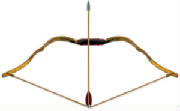Persian soldiers used a fairly short thrusting spear as their main weapon. Roughly 7 feet long, they were equipped with a
broad iron spearhead and counterbalanced by a round metal counterweight. In more elite units the counterweight was silver
for soldiers, their officers being equipped with golden ones while bronze counterweights were more common in the rank and
file of the Persian army.
 Originally developed by the Scythians, the early Achaemenid Persians adopted the akinakes as their main sword in combat. Roughly
20 inches long (give or take a few inches), the akinakes was worn on the right hip, near the soldier’s fighting
hand. The iron blade could be used for either cutting or stabbing, being double edged. Elite troops such as the famous Persian
Immortals, or Amrtaka, were the main users of the akinakes, common soldiers being too poor afford swords. Persian soldier’s
began using the weapon in the 7th century BC until it finally disappeared from history in the 2nd century BC.
The kopis was not limited just to the Greeks, but was utilized by the Persians as well. Infantry and cavalry carried this
heavy slashing sword.
 The bow was the core weapon of the Persian army, most of the infantry being armed with a powerful recurved bow similar to
the similar Scythian weapon. Recurved bows gained their power by bending the bow opposite to the natural curve of the weapon,
creating added tension and force. In battle the large numbers of Persian archers would fire in massive barrages, sending sheets
of arrows down on their opponents. Unfortunately, despite the power of their bow, the Persian arrows were extremely light,
made of cane and tipped with a three-flanged bronze arrowhead. Due to the lightness of the missile, Persian troops were unable
to puncture the heavy armor of Hellenistic soldiers. The recurved bow could be held in a carrying case hung on the back or
the left side of a soldier’s belt. In addition the quiver was worn on the hip and allowed for rapid fire, whether
on foot or on horseback. The famous Immortals also used the recurved bow, although they carried their quiver on their backs
to allow them to close for hand-to-hand combat.
 |